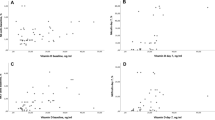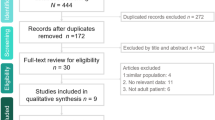Abstract
Objective:
To investigate whether vitamin B6 supplementation has a beneficial effect on immune responses in critically ill patients.
Design:
A single-blind intervention study.
Setting:
The study was performed at the Taichung Veterans General Hospital, the central part of Taiwan.
Subjects:
Fifty-one subjects who stayed over 14 days in the intensive care unit completed the study. Subjects were not treated with any vitamin supplement before the intervention.
Interventions:
Patients were randomly assigned to one of three groups, control (n=20), a daily injection of 50 mg vitamin B-6 (B6-50, n=15), or 100 mg vitamin B-6 (B6-100, n=16) for 14 days.
Main outcome measures:
Plasma pyridoxal 5′-phosphate (PLP), pyridoxal (PL), 4-pyridoxic acid (4-PA), erythrocyte alanine (EALT-AC) and aspartate (EAST-AC) aminotransaminase activity coefficient, and urinary 4-PA were measured. The levels of serum albumin, hemoglobin, hematocrit, high-sensitivity C-reactive protein (hs-CRP) and immune responses (white blood cell, neutrophils, total lymphocytes count (TLC), T- (CD3) and B-(CD19) lymphocytes, T-helper (CD4) and suppressor (CD8) cells) were determined.
Results:
Plasma PLP, PL, 4-PA and urinary 4-PA concentrations significantly increased in two treated groups. T-lymphocyte and T-helper cell numbers and the percentage of T-suppressor cell significantly increased on day 14 in the B6-50 group. Total lymphocyte count, T-helper and T-suppressor cell numbers, the percentage of T-lymphocyte cells and T-suppressors significantly increased in the B6-100 group at the 14th day. There were no significant changes with respect to immune responses in the control group over 14 days.
Conclusions:
A large dose of vitamin B6 supplementation (50 or 100 mg/day) could compensate for the lack of responsiveness of plasma PLP to vitamin B6 intake, and further increase immune response of critically ill patients.
Sponsorship:
This study was supported by the National Science Council, Taiwan, Republic of China (NSC-92-2320-B-040-026).
This is a preview of subscription content, access via your institution
Access options
Subscribe to this journal
Receive 12 print issues and online access
$259.00 per year
only $21.58 per issue
Buy this article
- Purchase on Springer Link
- Instant access to full article PDF
Prices may be subject to local taxes which are calculated during checkout
Similar content being viewed by others
References
Axlerod AE (1971). Immune processes in vitamin deficiency states. Am J Clin Nutr 24, 265–271.
Casciato DA, McAdam LP, Kopple JD, Bluestone R, Goldberg LS, Clements PJ et al. (1984). Immunologic abnormalities in hemodialysis patients: improvement after pyridoxine therapy. Nephron 38, 9–16.
Folkers K, Morita M, McRee Jr J (1993). The activities of coenzyme Q10 and vitamin B6 for immune responses. Biochem Biophys Res Commun 193, 88–92.
Food and Nutrition Board – Institute of Medicine (1998). Dietary Reference Intakes Thiamin, Riboflavin, Niacin, Vitamin B-6, Folate, Vitamin B-12, Pantothenic acid, Biotin, and Choline. National Academy Press: Washington, DC.
Gray A, McMillan DC, Wilson C, Williamson C, O'Reilly D St J, Talwar D (2004). The relationship between plasma and red cell concentrations of vitamins thiamine diphosphate, flavin adenine dinucleotide and pyridoxal 5-phospahte following elective knee arthroplasty. Clin Nutr 23, 1080–1083.
Ha C, Miller LT, Kerkvliet NI (1984). The effect of vitamin B6 deficiency on cytotoxic immune responses of T cells, antibodies, and natural killer cells, and phagocytosis by macrophages. Cell Immunol 85, 318–329.
Huang YC, Chang HH, Huang SC, Cheng CH, Lee BJ, Cheng SY et al. (2005). Plasma pyridoxal 5′-phosphate is a significant indicator of immune responses in the mechanically ventilated critically ill. Nutrition 21, 779–785.
Huang YC, Lan PH, Cheng CH, Lee BJ, Kan MN (2002). Vitamin B6 intakes and status of mechanically ventilated critically ill patients in Taiwan. Eur J Clin Nutr 56, 387–392.
Huppert FA, Solomour W, O'Connor S, Morgan K, Sussams P, Brayne C (1998). Aging and lymphocyte subpopulations: whole-blood analysis of immune markers in a large population sample of elderly individuals. Exp Gerontol 33, 593–600.
Kumar M, Axelrod AE (1968). Cellular antibody synthesis in vitamin B-6 deficient rats. J Nutr 96, 53–59.
Leklem JE (1990). Vitamin B6: a status report. J Nutr 120, 1503–1507.
Louw JA, Werbeck A, Louw ME, Kotze TJ, Cooper R, Labadarios D (1992). Blood vitamin concentrations during the acute-phase response. Crit Care Med 20, 934–941.
Merrill AH, Henderson JM (1987). Diseases associated with defects in vitamin B6 metabolism or utilization. Ann Rev Nutr 7, 137–156.
Quasim T, McMillan DC, Talwar D, Vasilaki A, O'Reilly D StJ, Kinsella J (2005). The relationship between plasma and red cell B-vitamin concentrations in critically-ill patients. Clin Nutr 24, 956–960.
Sergeev AV, Bykovskaja SN, Luchanskaja LM, Rauschenbach MO (1978). Pyridoxine deficiency and cytotoxicity of T lymphocytes in vitro. Cell Immunol 38, 187–192.
Talbott MC, Miller LT, Kerkvliet NI (1987). Pyridoxine supplementation: effect on lymphocyte responses in elderly persons. Am J Clin Nutr 46, 659–664.
Talwar D, Quasim T, McMillan DC, Kinsella J, Williamson C, O'Reilly DStJ (2003a). Pyridoxal phosphate decreases in plasma but not erythrocytes during systemic inflammatory response. Clin Chem 49, 515–518.
Talwar D, Quasim T, McMillan DC, Kinsella J, Williamson C, O'Reilly DStJ (2003b). Optimisation and validation of a sensitive high-performance liquid chromatography assay for routine measurement of pyridoxal 5-phosphate in human plasma and red cells using pre-column semicarbazide derivatisation. J Chromatogr B Analyt Technol Biomed Life Sci 792, 333–343.
Willis-Carr JI, St Pierre RL (1978). Effects of vitamin B-6 deficiency on thymic epithelial cells and T lymphocyte differentiation. J Immunol 120, 1153–1159.
Woodring MJ, Storvick CA (1970). Effect of pyridoxine supplementation on glutamic–pyruvic transaminase, and in vitro stimulation in erythrocytes of normal women. Am J Clin Nutr 23, 1385–1395.
Author information
Authors and Affiliations
Corresponding author
Additional information
Guarantor: YC Huang.
Contributors: C-HC was responsible for the screening and intervention of subjects and interpretation of the results. S-JC was responsible for data coding, sample analyses, and statistical analyses. B-JL was responsible for the screening and intervention of subjects. K-LL was responsible for the hematological measurements. Y-CH was responsible for the development of intellectual content and the study design, interpretation of the results, and manuscript drafting.
Rights and permissions
About this article
Cite this article
Cheng, CH., Chang, SJ., Lee, BJ. et al. Vitamin B6 supplementation increases immune responses in critically ill patients. Eur J Clin Nutr 60, 1207–1213 (2006). https://doi.org/10.1038/sj.ejcn.1602439
Received:
Revised:
Accepted:
Published:
Issue Date:
DOI: https://doi.org/10.1038/sj.ejcn.1602439
Keywords
This article is cited by
-
Factors influencing vitamin B6 status in domestic cats: age, disease, and body condition score
Scientific Reports (2024)
-
The effect of supplementation with vitamins A, B, C, D, and E on disease severity and inflammatory responses in patients with COVID-19: a randomized clinical trial
Trials (2021)
-
Healthy Human Gastrointestinal Microbiome: Composition and Function After a Decade of Exploration
Digestive Diseases and Sciences (2020)
-
Vitamin B6 Reduces Neurochemical and Long-Term Cognitive Alterations After Polymicrobial Sepsis: Involvement of the Kynurenine Pathway Modulation
Molecular Neurobiology (2018)
-
Relationship between total fruit and vegetable intake and self-reported knee pain in older adults
The Journal of nutrition, health and aging (2017)



